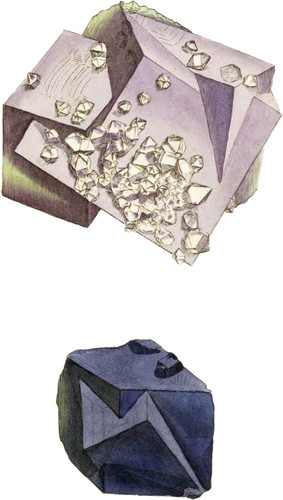 Enlarge
Enlarge
British Mineralogy
Fluate of Lime. Cubic
- Class 2. Earth.
- Order 1. Homogeneous.
- Gen. Lime.
- Spec. 4. Fluate of Lime.
- Div. 1. Crystallized.
- Spec. Char.
- Lime combined with fluoric acid, which acid has the peculiar property of dissolving siliceous substances, or flint.
- Chaux fluorée. Born, v. 1. 355.
- Fluss. Emmerling, v. 1. 515.
- Fluor. Kirwan, v. 1. 1.124.
- Chaux Fluaté cubique. Haüy, v. 2. 247. A11 A1i
Fluor is divisible into regular octaëdrons. Spec. grav. 3.0943 to 3.1911, and according to Haüy has a regular tetraëdron for its integrant molecule. It is mostly found crystallized in cubes (more rarely in octaëdrons and their modifications) in many parts of Great Britain, as Derbyshire, Cumberland, two places in Scotland*; also in Devonshire and Cornwall. It may be fused by the blowpipe into a transparent glass†. Its refraction is single. The powder projected on a hot poker gives a phosphorescent light, of a bright and glowing purplish or lilac colour. The Rev. Mr. J. Dalton favoured me with some from Cumberland, greenish within, and of a dull pale crimson on the outside, which gives this glow in great perfection, in rather large pieces, without cracking or dispersing so soon as usual; and if not too much heated, the same pieces will do again. In this agrees with the chlorophane of Siberia, which much resembles it in external appearance, but gives a verditer green glow on exposure to heat without falling to pieces.
The fluoric acid was discovered by Scheele. It may be disengaged from the lime by means of dilute sulphuric acid, and has been used for etching on glass. One of the methods may be acceptable to my general readers. Having a plate or piece of glass thinly covered with wax, edtch, or draw, by cutting through the wax with a point or needle whatever may be desired, placing the glass horizontally, so as to retain the fluid, (it may be best perhaps to surround the plate with a wall of wax, for greater security); then having some fluor pounded into a fine dust, sift or spread it over the whole within the waxen wall. Mix one part of sulphuric acid or two or three of water, and pour it on gently. The strength of the strokes will depend on the quantity of dust of fluor, and the strength of the acid that is to decompose it. Very little practice will show the proper strength of the ingredients to corrode a certain depth in the glass, where the strokes were drawn. The rising fumes will etch another prepared glass, if placed so as to receive them, and perhaps more regularly. The acid for chemical purposes is commonly procured in a leaden apparatus.
I have figured two specimens of the most common appearance of fluor. The upper one deviates a little in form, the middle cube being interrupted by the side ones, contracting its upper part, so that the lower is much the broadest. There are some crystals of what is commonly called eighteen-sided quartz sticking about them, as usual with fluor from Cumberland.
The lower figure seems altogether of a fine deep purple, but is only thinly coated, the inside being of an olive green. The faces are remarkable for having signs of the laminæ of superposition, indicating four-sided pyramids, the apex of which appears at the edges of the cubes whre in contact.
Fig. 1. shows a corner of one of the cubes replaced by six minute triangular facets.
The upper figure has some signs of superposition, though scarcely more than scratches, giving the specimen a greasy appearance. The hexangular cavity is where a crystal of quartz had stuck, and shows that the side inserted was not regular: hence it appears that the crystals of quartz are not regularly eighteen-sided, their shape being interrupted by the fluor.
- * Aberdeenshire and Shetland. Jameson, v. 1. 151.
- † It is apt to crack and disperse; which may be prevented by powdering it.

